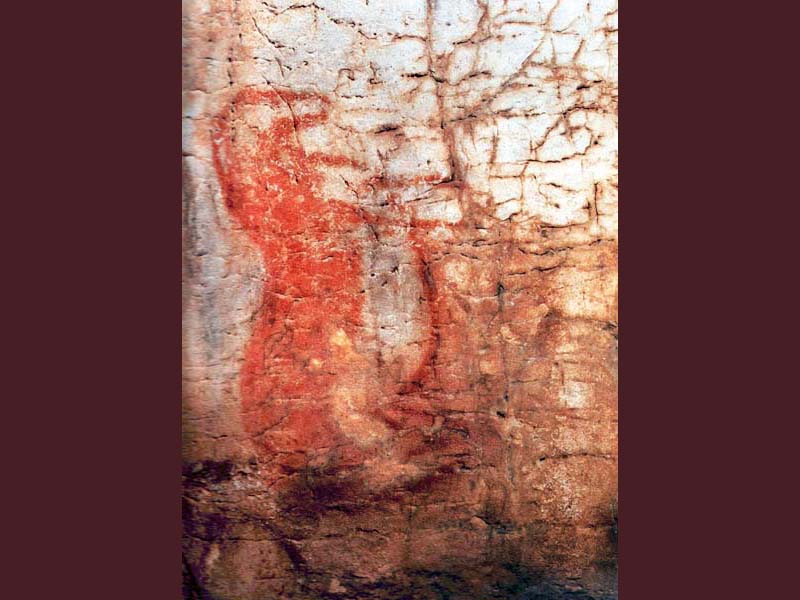The Paglicci deposit consists of a shelter under the rock and an adjacent cave dating back to the Lower, Middle and Upper Paleolithic, therefore datable between 500 and 11 years ago; inside more than 45.000 finds have been found to date, including two entire burials from the Upper Paleolithic, wall paintings of horses in red ocher, hearths, artistic and anthropomorphic graffiti on pebbles, bones and boulders, remains of meals and banquets, evidence of archaic religious cultures, all elements that make Paglicci one of the most significant sites in Italy for the study of Paleolithic populations.
The wall paintings were discovered in a very internal room of the cave and include two horses (one of which represented vertically, Fig. 1, and the other larger represented in profile, Fig. 2) and a series of hands. The two complete horses are represented in an archaic style that recalls that of Franco-Cantabrian art, in a static position with voluminous and swollen bellies, so much so as to suggest pregnant mares, of an intense red colour. Among the group of hands (at least five certainly recognizable), some are "positive", i.e. painted by direct impression of the hands smeared with color, others are "negative", i.e. made by spraying color around them, Fig. 3. Furthermore, it is a fragment of a limestone slab painted in red ocher was found, measuring 22,2×14,3×5,6 cm., depicting the back of a horse running to the right, Fig. 4; the latter was found at the base of the layer referring to the ancient Epigravettian, dated to about 18.800 - 15.600 years ago, probably collapsed from the ceiling of the entrance hall as the painted side has a smooth and regular surface, while the face opposite and the lateral ones have an irregular surface caused as if by a fracture from the anciently painted ceiling of the cave. The find must have had a total length of about 45 cm.
Among the many movable art objects found inside the cave, the oldest is represented by a fragment of the tibia of a large mammal, with a maximum size of 23,2×6,5 cm., bearing a series of engravings and dated around 22.000 years ago showing an ibex seen in profile, fig. 5. The proportions of the animal are perfectly respected with various details, such as the eye with its tear duct, the wide curved horns, the bristling mane and the tuft of hair at the end of the tail; above and to the sides of the animal there are a series of lines, some with a vertical course, others oblique and others with a "chevron" motif. The Paglicci ibex is to be considered as the most ancient paleolithic art manifestation dated to C14 and so far found in Italy; its graphic and stylistic characteristics are defined as archaic as the strokes are simple and coarse, despite the fact that the final effect is rather naturalistic and some parts are treated with particular care and formal elegance (see the detail of the eye).
Another important fragment, dating back to around 15.000 years ago, is engraved on both sides with zoomorphic figures; on one side a lively hunting scene is engraved, with a running horse flanked prospectively by two deer followed by a cloud of darts, fig. 6; on the opposite face is represented the head of an ox with large horns stretched forward, partially superimposed by the head of another smaller bovid and the profile of a fawn, fig. 7.
Another irregularly rounded pebble, measuring 17,6×10,7×6,5 cm., has on one face a bovine head seen in left profile, with a squared snout, well-defined nose, eyes and mouth and with the left horn extended forward while the right follows the progress of the other with a broken line. Other non-decipherable signs are superimposed on the same face of the pebble, fig. 8.
On another irregularly flattened dark gray pebble, measuring 12x11x3,1 cm, the figure of a standing horse turned to the left has been inserted; the major details are outlined in the head, with the eye and one ear well outlined, while the rest of the body is summary and the legs are faded without the detail of the hooves. The horse's belly is engraved by about a dozen arrows, but the one that arouses particular attention is one that penetrates above the attachment of the foreleg, in the direction of the heart, a detail that supports the hypothesis that the function of these depictions of animals was connected with the practices of hunting magic, fig. 9.
On a flattened yellow ocher pebble, measuring 6,3×5,3×1,4 cm, at least two phases of incisions can be distinguished for the main face: the oldest is made up of a series of lines of not easy to interpret, variously arranged along the entire surface of the pebble, which seem to determine the figure of a bird with a beak (for some an ibex is represented) and a large plumage, but the characteristics do not allow to specify which avian species is represented ; a further hypothesis, the subsequent engraving phase instead identifies a bovine head, perhaps that of a bull, seen in profile with well defined eye, nose and mouth. On the occipital part, near the horns, there is a deep V-shaped sign whose meaning is not clear, interpreted as the symbol of an arrow or a wound. On the opposite face of the pebble, the head of another bovine is engraved, seen in the right profile, but in this case the image is strongly compromised by a chip. The features of this bovine seem much more delicate, which has led to the hypothesis that on one side a female bovid and a male on the other were represented on this pebble, fig. 10.
On a small fragment of the left coxal of an equid, measuring 6×5,1×2,3 cm, part of the head of a bovine can be recognized in the right profile, incomplete due to recent breakages. The almond-shaped eye, the nose and the thick fur are evident, indicated by a series of consecutive curved lines arranged obliquely; a curious detail are the horns, represented with a series of staggered lines, facing forward but with the apex bending backwards, as if to indicate the movement of the ox's head, fig. 11.
On a small bone fragment of the left scapula of cervus elaphus, with dimensions of 5,5×4,2×0,5 cm., the head of a cervid was engraved, seen in the right profile; unfortunately the find has been damaged in several places in recent times by treasure seekers, therefore the horns have remained well represented, engraved in several lines, perhaps to indicate a series of horns in perspective belonging to several animals, fig. 12.
On a limestone block measuring 34x21x12,6 cm., found with the engraved face facing downwards, there are depicted the left profile of a bovid and a deer, both engraved with a very thin and light stroke, fig. 13.
On a limestone block measuring 27,5×16,9×8,7 cm., found with the engraved face facing upwards, the profile of a bird belonging to the genus Alca is depicted, most likely it is the extinct Alca impennis, outlined with an acute naturalistic sense in the definition of unmistakable details such as the beak and the summer nuptial livery of this bird. The representations of this bird in Paleolithic art are very rare, even if a graffiti specimen has recently been found in Romanelli cave, both therefore evidence of the presence of the Alca impennis along the Apulian coasts, fig. 14.
There are many other finds found inside the cave, some of which engraved with indecipherable geometric and schematic motifs and some with signs that could be interpreted as highly schematized representations of the female figure, recognizable above all by the characteristic expansion of the buttocks and legs of the style Gonnersdorf, fig. 15.

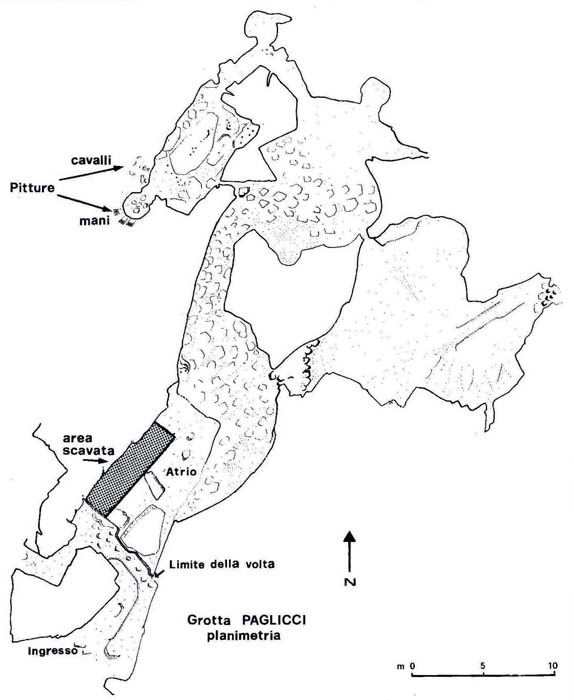
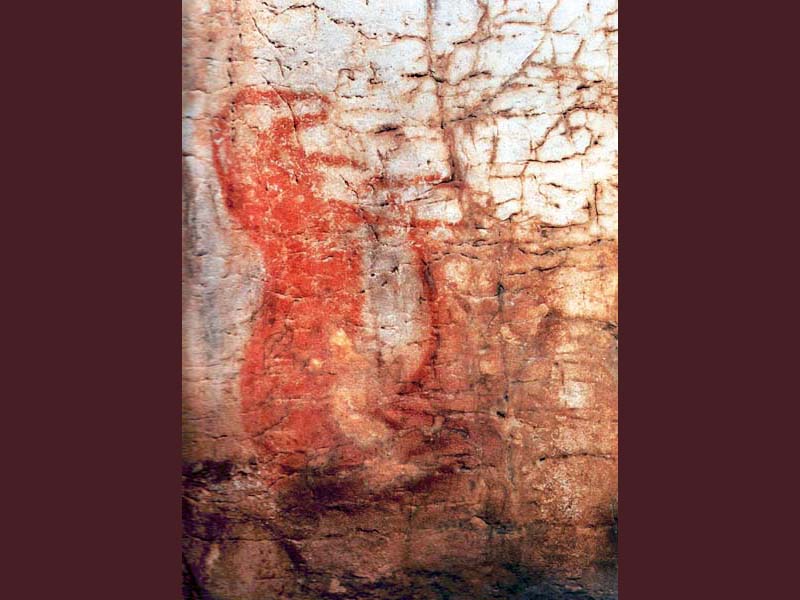
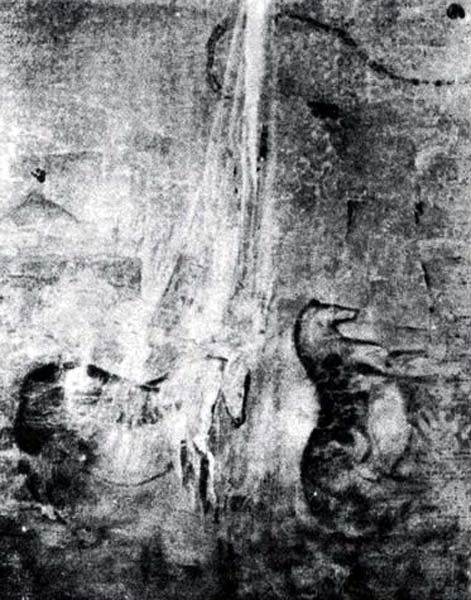
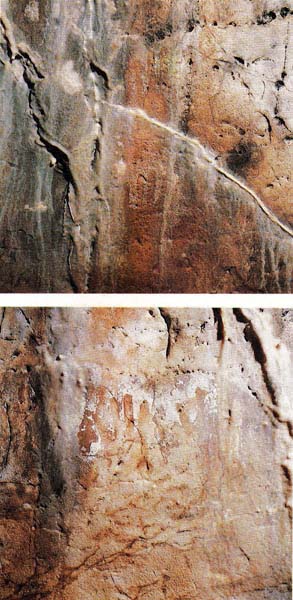
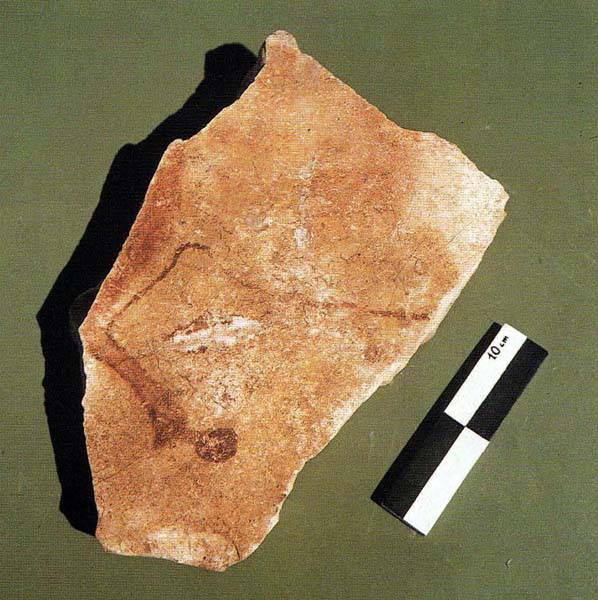
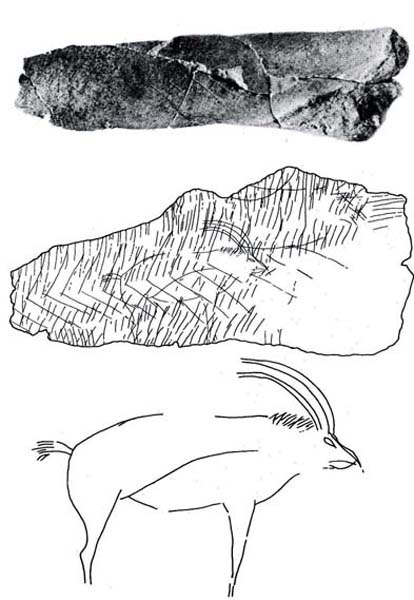
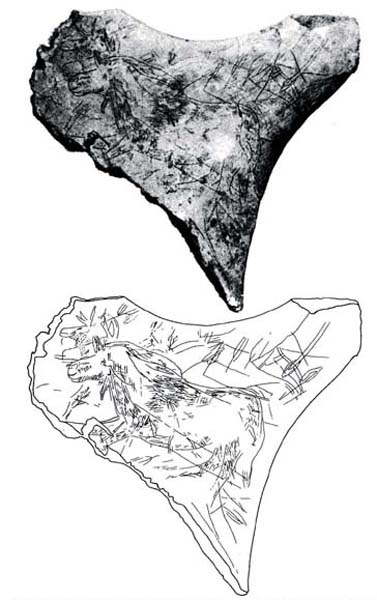
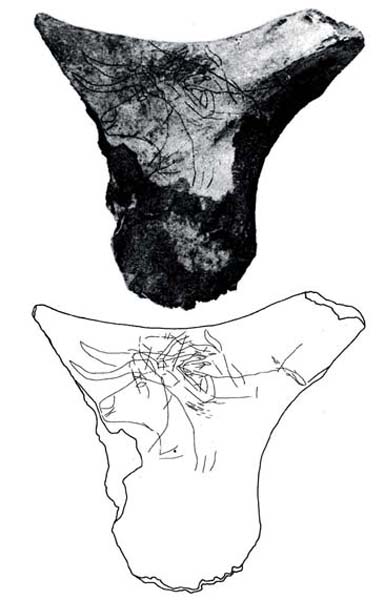
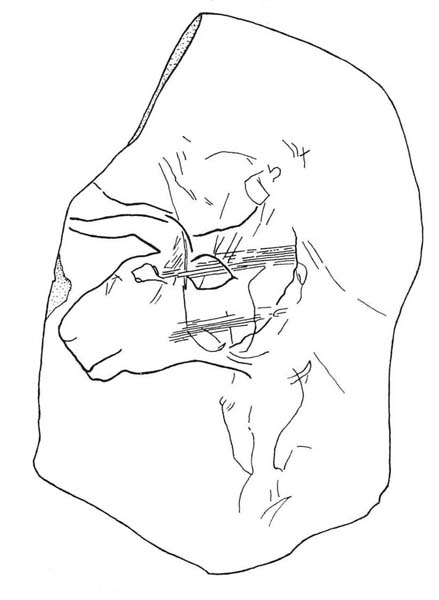
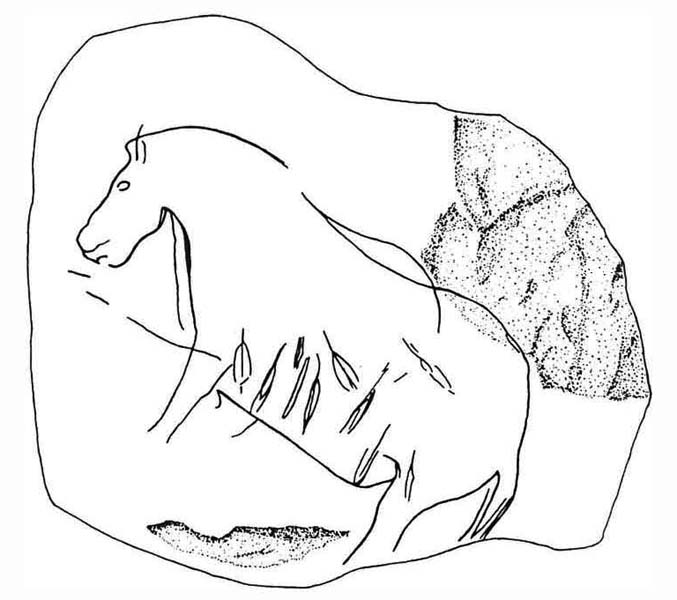


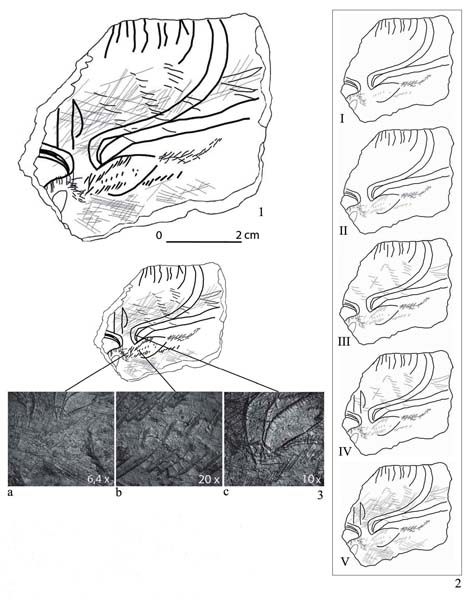
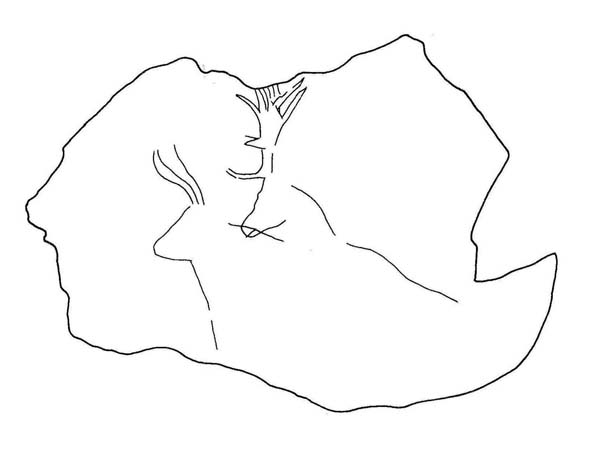

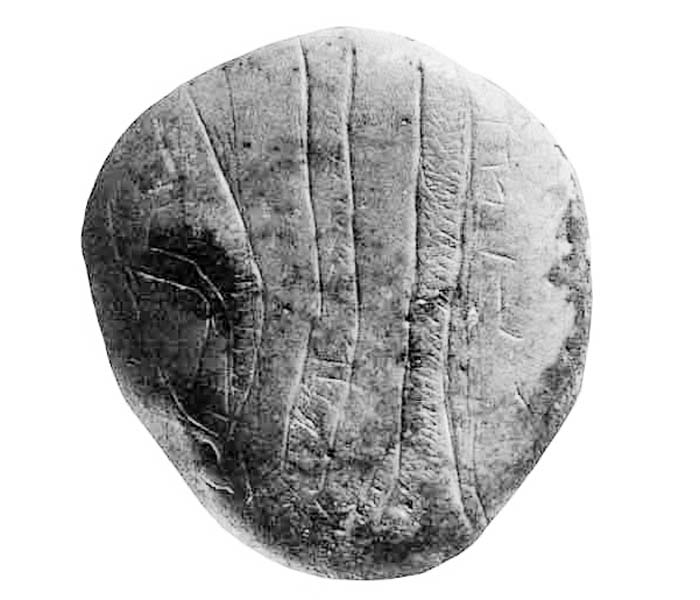
Historical notes
The first lithic remains found near the cave were discovered by chance by a group of local characters, including a geology student, attracted to the area by the mystery of the treasure hidden by the brigand Gabriele Galardi, who took refuge in the 60s in the cave during a bandit revolt, hiding inside all the loot collected in several years of robberies and extortions. The rumor of the discovery of the cave struck the well-known anthropologist and palethnologist of the University of Padua, Raffaele Battaglia who, in 1955 went to the Gargano and having ascertained the veracity of the discovery, he reported it in his turn. The news was received by Francesco Zorzi, director at the time of the Civic Museum of Natural History of Verona, who in 1960 made an inspection together with the geologist Angelo Pasa, the Prof. of the University of Florence Fiorenzo Mancini, the young student Franco Mezzena and to the well-known archaeologist Arturo Palma di Cesnòla; the following year the first excavation campaign began inside the atrium of the cave (Zorzi, Pasa and Mezzena) excavations which continued until 1963, bringing to light some human remains, art objects graffiti on bone and the painting room. In 1964 Prof. Francesco Zorzi passed away, therefore excavations were interrupted for a long time while the deposit fell prey to clandestine scavengers but above all to an avid treasure seeker, Mr. Leonardo Esposito who, convinced of the existence of the buried treasure by the brigand, he operated a slow and undisturbed demolition of the field, also making recurrent use of explosives. Excavations resumed in the spring of 1971, by the University of Siena, coordinated by the archaeologist Palma di Cesnòla, with three excavation campaigns extended to the External Shelter and the first room of the cave, excavations which continued until 2004. In the External Shelter an important stratigraphic series has been brought to light from the Lower Paleolithic (200-300.000 years ago), Middle Paleolithic (from 80 to 50.000 years ago), up to the Upper Paleolithic where the burial of the woman under ocher was found, with funeral equipment, the “Paglicci's young mother”. The Outer Shelter was originally supported by a rocky ceiling, destroyed first by cataclysms and then by the famous treasure seeker with the shooting of mines, therefore it is now completely open to the sky; for the researchers it turns out to be the most important part of the deposit, the one that supplied the most archaic finds.
CARD
LATEST PUBLISHED TEXTS
VISIT THE FACTSHEETS BY OBJECT

